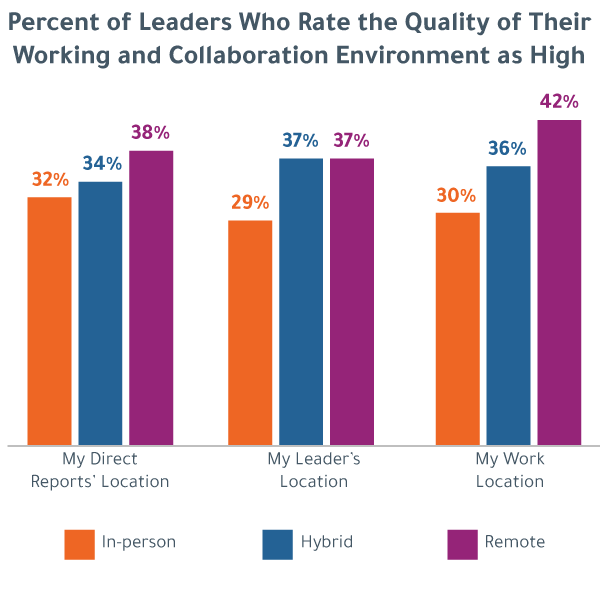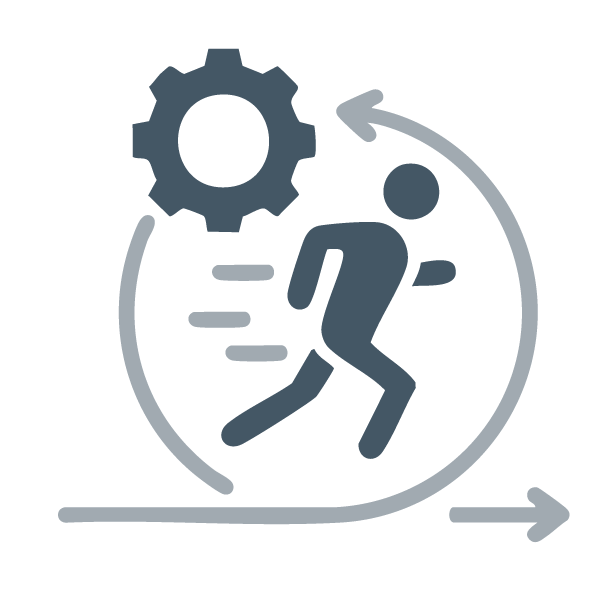As we speed toward a future shaped by AI, automation, and digital change, it’s tempting to think that leadership will depend on mastering technologies.
Yet, a surprising truth stands out among leadership trends for 2025: the most important skill won't be technical prowess, but the ability to forge genuine human connections.
As organizations face AI integration, hybrid work challenges, demand for versatile talent, and a looming leadership pipeline crisis, it's clear that human connection is our most powerful tool for navigating these issues.
The leaders who will thrive in 2025 and beyond are those who can inspire resilient, innovative teams by fostering trust and genuine connections.
In this article, we'll explore the key leadership trends for 2025 that underscore why human connection isn't just a "nice to have"—it's the cornerstone of future organizational success.

Trend #1: The AI and Innovation Paradox: Balancing Technology and Human Touch
In today’s evolving AI landscape, the role of leaders has never been more crucial to driving successful outcomes at work.
As part of our Global Leadership Forecast 2025, we’ve been listening to leaders and learning more about their experiences with AI at work. Across all industries and functions—technology, sales, marketing, finance, and beyond—leaders are facing the ethical complexities of AI. Employees are increasingly concerned about job security and surveillance, bringing these issues to the forefront. AI promises greater efficiency and innovation, but we must consider how these technologies impact employees’ lives and work.
Over the past year, AI in the workplace has matured from initial excitement and experimentation to more thoughtful, practical, and ethical applications. This shift has more potential to affect teams and cause discomfort for those who prefer traditional ways of working.
Leaders play an essential role in balancing AI's vast economic potential with a focus on the human aspect of work.
To truly thrive with AI, leaders must recognize that its power lies in augmenting, not replacing, human connection. Interpersonal skills are more important than ever, and the organizations that succeed will be those that use AI to empower employees and foster collaboration, innovation, and trust.
Across all industries and functions—technology, sales, marketing, finance, and beyond—leaders are facing the ethical complexities of AI.

Trend #2: Beyond Physical Workspaces: Fostering Connection and Trust in a Hybrid World
The shift to hybrid and remote work has changed how teams connect and collaborate. In many organizations where employees are spread across locations and time zones, traditional ways of building rapport and fostering equitable experiences are almost obsolete.
Though there were doubts about leaders’ abilities to maintain strong connections and collaboration in hybrid or remote settings, signs show that remote and hybrid leaders are outperforming their in-person counterparts.

Our Global Leadership Forecast 2025 found that leaders who manage hybrid and remote teams are 2.5X more likely to be prepared to foster connection and inclusion among employees.
This finding challenges the traditional belief that collaboration depends on in-person interactions. So, what are these leaders doing differently?
We found that hybrid and remote managers excel in two critical areas: they consistently ask about their employees’ wellbeing and maintain trust. This behavior helps hybrid and remote managers foster positive connections with their team members, strengthening trust and loyalty.
These stronger connections benefit leaders, too. Leaders who work in remote or hybrid teams were 3X more likely to have high engagement and 2X less likely to intend to leave within the year when compared to their counterparts who work in person.
These findings shine a light on how leadership connections drive collaboration and positive employee experiences. What leaders do matters more than where they work.

These findings reshape the return-to-office debate. Executives are wrestling with what seems like an impossible choice: either limit the talent pool and bring employees back to the office, or attract more talent by embracing remote work but risk team cohesion. In reality, this may be a false dilemma.
Workplaces don’t have to choose one extreme or the other. The most successful leaders take a balanced approach, valuing employee flexibility while fostering connection and collaboration. This allows them to build agile, innovative teams that thrive anywhere.

Trend #3: The Power of Future-Focused Mindsets: Developing Versatile Talent
Business is moving at a breakneck pace and leaders are facing unmatched levels of complexity and constantly rising consumer expectations. With customers demanding more personalized, seamless, and impactful experiences, simply keeping up is not enough.
Adding to this challenge is a trend of underconsumption, or what some call "non-consumption core." In other words, consumers are spending less and becoming more selective with their dollars. This means that companies must work harder than ever to capture and retain attention. Building brand loyalty now requires not just quality, but also value and relevance in every interaction.
In this high-stakes environment, organizations must change quickly, evolving their strategies, offerings, and internal cultures to stay competitive.
Leaders are at the forefront of this change. They need to stay agile and continuously learn new skills to effectively navigate and lead through new challenges. They must guide their teams to embrace agility and adaptability as core strengths. By fostering a connected, collaborative culture, leaders can unite their teams with a shared sense of purpose. This makes teams capable of responding quickly to market shifts, pushing the boundaries of innovation, and meeting evolving consumer needs head-on.
Strong interpersonal connections within teams are essential to unlocking this level of responsiveness. When team members feel connected and aligned, they bring creativity, insight, and flexibility to their daily work. Leaders who understand the power of these social dynamics can transform their teams into adaptable powerhouses, ready to navigate the complexities of the modern business landscape with both agility and resilience.
Ultimately, the future belongs to those who can harness human connection to drive adaptability and innovation. In a world where change is constant, leaders who prioritize these connections and growth opportunities will shape organizations that thrive amid uncertainty. They’ll set the pace for the industry and capture consumer loyalty for years to come.
In this high-stakes environment, organizations must change quickly, evolving their strategies, offerings, and internal cultures to stay competitive.

Trend #4: The Leadership Pipeline Crisis: Addressing Burnout and the Undesirable Leadership Role
Today’s challenging leadership landscape presents a crisis: a shrinking leadership pipeline. Organizations face a growing struggle to identify emerging leaders and fill leadership roles, risking the stability of team connections and the quality of team performance.
As the stress and isolation of leadership roles increase, leaders themselves experience higher levels of burnout and disengagement. This impacts team morale and productivity, and the trust that binds teams begins to fray.
The result is a reinforcing cycle: as team members witness the toll leadership takes on their managers, many are hesitant to pursue these roles themselves. This cycle has led to a trend called “conscious unbossing." Younger generations, especially Gen Z, increasingly choose alternate career paths, such as entrepreneurship or specialist roles, over traditional management tracks.
This shift is more than just a temporary trend; it’s a signal of a long-term risk to organizational stability. Without enough willing and well-prepared leaders to step up, the effects of burnout and disengagement are likely to cascade, impacting employee retention, customer satisfaction, and ultimately, the bottom line.
While this shift is profound, it’s not insurmountable. Now more than ever, organizations must rethink how they nurture and support leaders. By investing in structures and cultures that prioritize leader wellbeing, resilience, and a sense of connection, companies can build a sustainable leadership pipeline. Proactive steps today will help ensure healthier, more connected teams and a stronger foundation for the future.
As the stress and isolation of leadership roles increase, leaders themselves experience higher levels of burnout and disengagement.
What Leaders Need to Do in 2025 to Build Connection
The year ahead calls for leaders to embrace five core practices that strengthen team bonds and create more resilient, connected organizations.
1. Build trust through flexibility, empathy, and transparent communication.
Trust is essential for connection, and it’s fostered through flexibility, understanding, and open communication. The most effective leaders are emotionally intelligent ones. Share your own challenges and learning experiences to create a culture of openness and authenticity. Empathetic leaders who communicate openly create a supportive environment where team members feel seen, heard, and valued.
2. Use technology to enhance, not diminish, team relationships.
In both remote and hybrid work environments, technology should serve as a bridge, not a barrier. Inclusive tools that support collaboration are key. And AI, if used thoughtfully, can augment team connections rather than replace them.
3. Provide regular feedback, stretch assignments, and collaborative learning opportunities.
To nurture team adaptability, leaders must offer consistent feedback, challenging projects, and spaces for learning. This approach allows teams to grow alongside evolving technologies like AI. Mentorship can also play a vital role, especially when leaders show genuine enthusiasm and model healthy boundaries. Mentorship can encourage emerging talent to consider leadership roles.
4. Promote collaboration and psychological safety to build agile teams.
When leaders create an environment where team members feel safe to voice ideas, take calculated risks, and learn from failures without fear, they unlock the team’s collective intelligence and creativity. Psychological safety and collaboration help teams quickly adapt, innovate, and respond to market changes enabling organizations to thrive.
5. Lead by example in wellness and work-life balance.
Leaders who demonstrate healthy work-life boundaries set a powerful example that fosters trust and mutual respect. For example, not sending emails outside work hours and taking allotted vacation time. By openly prioritizing their own wellbeing, leaders create a psychologically safe environment where team members feel empowered to do the same. This strengthens the human connection within the team. Moreover, when leaders are away team members can step up, take on new responsibilities, and grow their skills.
However, leaders can’t excel in these five practices without self-awareness and a commitment to growth. They need feedback and insights about their strengths and areas for improvement. Embracing vulnerability is essential for real development. By adopting these strategies and their own need to grow, leaders can create a connected, supportive culture where team members feel engaged, empowered, and ready to tackle the challenges of the future together.
What Do Leaders Need from Organizations in 2025?
Organizations must evolve their approach to leadership development in 2025, moving beyond traditional training to create comprehensive support systems that help leaders thrive in an increasingly complex environment.
- Leaders need ongoing insights into their skills. Assessments can provide immediate, objective, and ongoing insights into their strengths and areas for growth, helping them focus on what matters most and informing their personalized development plan.
- Leaders need robust support systems and resources for development. To grow and thrive, leaders need personalized development plans to help them close skill gaps, and mentorship to successfully navigate the diverse challenges they face daily.
- Leaders need to feel that they matter, and leadership is valued. Organizations must recognize and reward leaders who prioritize connection and trust. This creates a culture where leaders are motivated to invest in their teams.
- Leadership needs to be a sustainable career path to attract and retain next-gen talent. Making leadership a balanced, sustainable role will help attract top (next-gen) talent and encourage them to stay.
When organizations invest in leaders, they build more than individual leaders. They create resilient teams that drive innovation and strengthen connections across the organization. This investment in leadership doesn’t just solve today’s challenges—it builds a foundation for successfully navigating tomorrow's changes.
The Biggest Leadership Trend in 2025 Will be Connection
All these trends point to one truth. In the face of AI adoption, hybrid work, workforce agility, and succession challenges, effective leaders will determine which companies thrive and which falter.
The personal connections leaders build will create resilient, innovative teams that can thrive in a fast-changing world.
While building connection certainly isn’t new, it’s frequently forgotten in the everyday hustle and bustle of leadership. With so much going on, it’s easy for leaders (and organizations) to be shortsighted in their actions and reactions.
The organizations and leaders who thrive in 2025 will be those that master the art of human connection.
And connected leadership isn't just good for business—it turns the often-lonely role of leadership into a fulfilling experience of shared growth and achievement.
Learn more about DDI’s leadership development solutions.
Stephanie Neal is director of the Center for Analytics and Behavioral Research (CABER). She leads market and trend research focused on leadership and business innovation and is the general manager and lead author of DDI's Global Leadership Forecast.
Topics covered in this blog


